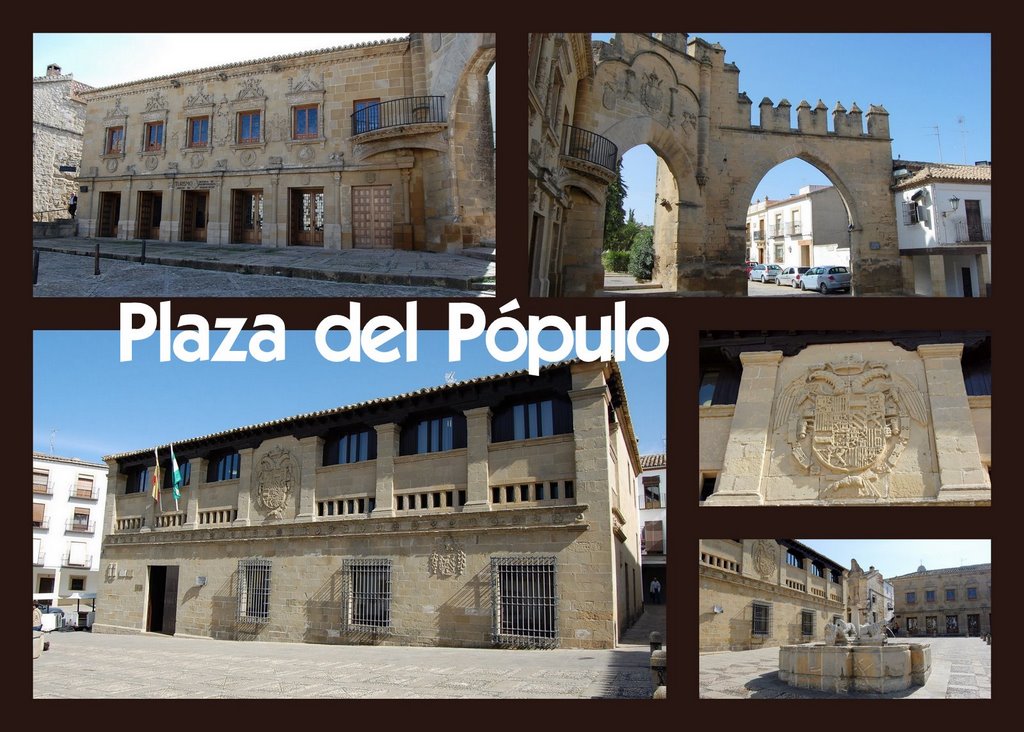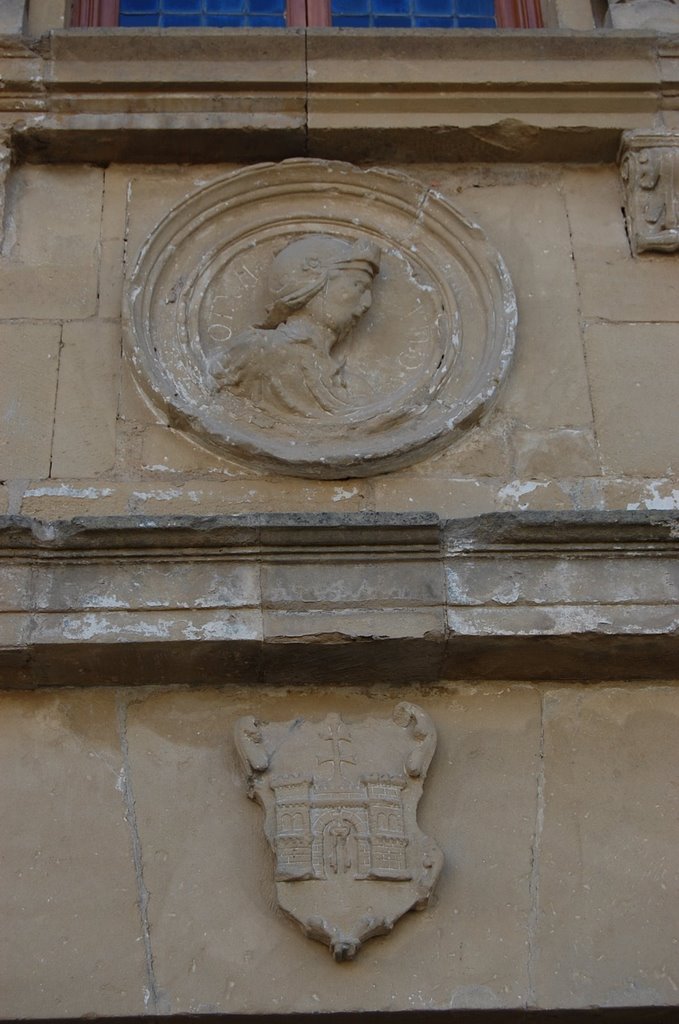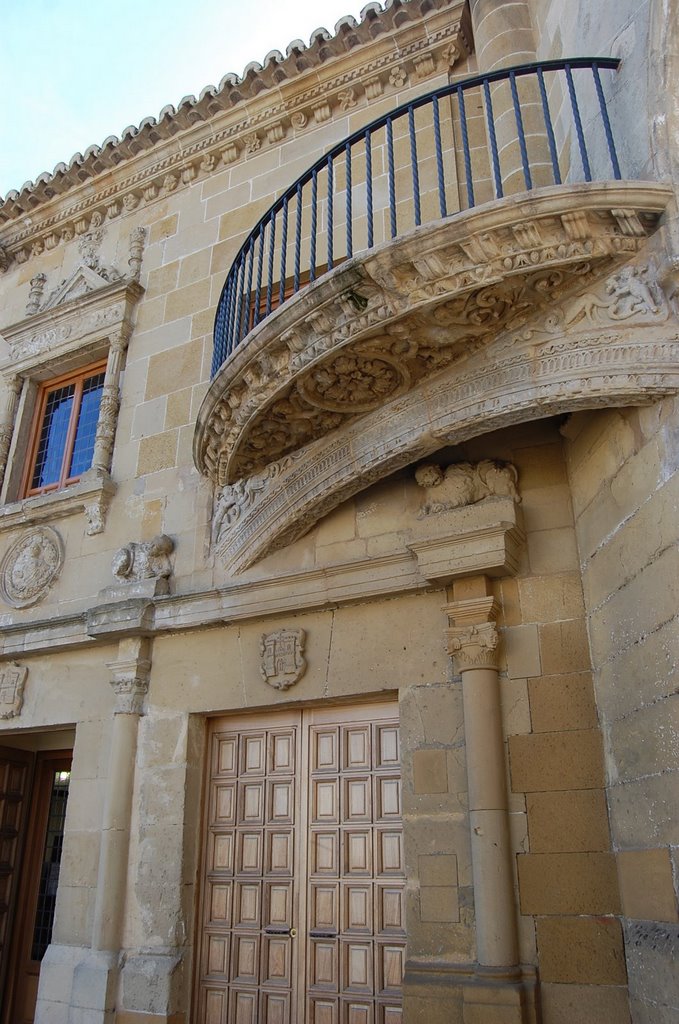Baeza's Plaza del Pópulo is
also called Plaza de los Leones after the fountain
in the foreground below. It has two major historic
buildings and a commemorative arch. Stones here remind us
of history stretching back to the days when Carthage
fought Rome in the third century BC -- and later when the
Spanish nobles fought their new Emperor in the 1500s.
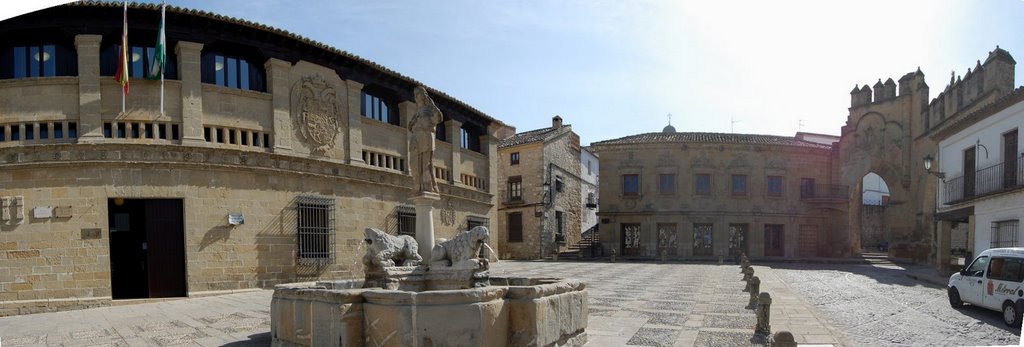
Baeza spans three gentle hills. One descends from the
cathedral to the large and lively Plaza de la
Constitución. About halfway, it stops at the bit
of a plateau shown above: the Plaza del Pópulo. We
found the square empty just before the start of a Monday
siesta. Note the absence of cars in the monumental
squares, as was the case in nearby Úbeda. In the
foreground is the Fuente (fountain) of the Leones, at
left the old butcher shop, back center is the Casa del
Pópulo attached to the Arco (memorial arch) de
Villalar.
Fuenta de los
Leones
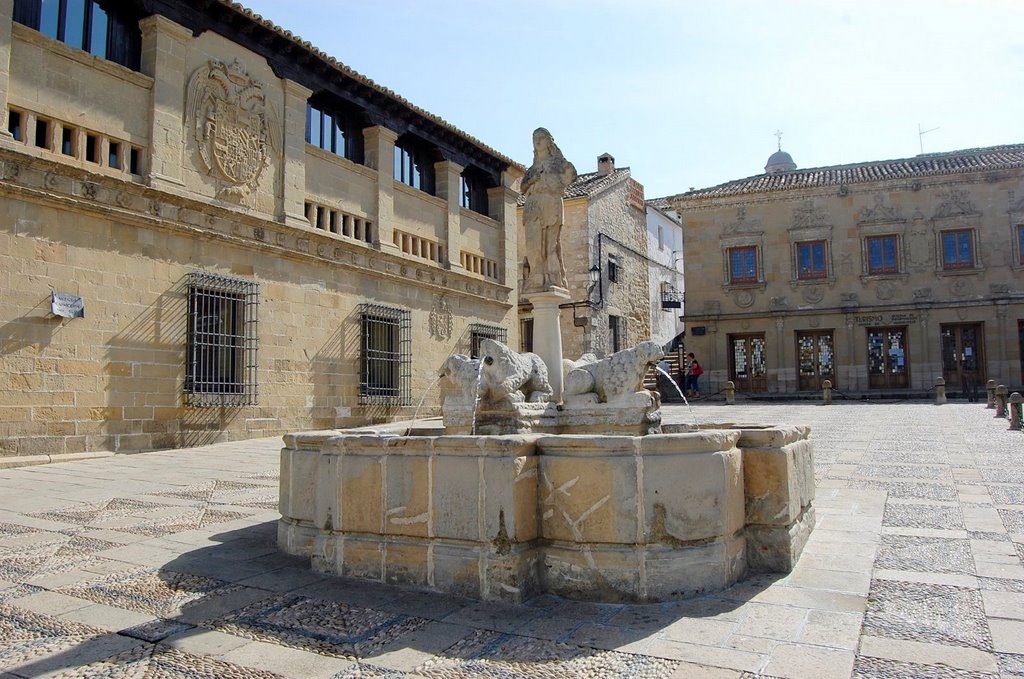
The Fuenta de los Leones (Fountain of the Lions) was
assembled from the ruins of the once nearby town of
Cástulo. The statue is of Cástulo’s
princess Himilce who married Hannibal as Carthage
prepared in Spain to take on those upstart Romans in the
Second Punic War. During the Visigoth and Moorish eras,
the town faded and much of it migrated – first the
mint, then the bishopric, and eventually the very
buildings were moved stone by stone -- to Baeza. What was
left of Cástulo became a haven for bandits and it
was leveled like a crack house in the 15th century. Today
not even archeological excavations take place in what was
the Roman’s largest town in Iberia. These
deteriorated lions and their princess remind us
“Sic transit gloria Cástulo.”
Antigua
Carniceria
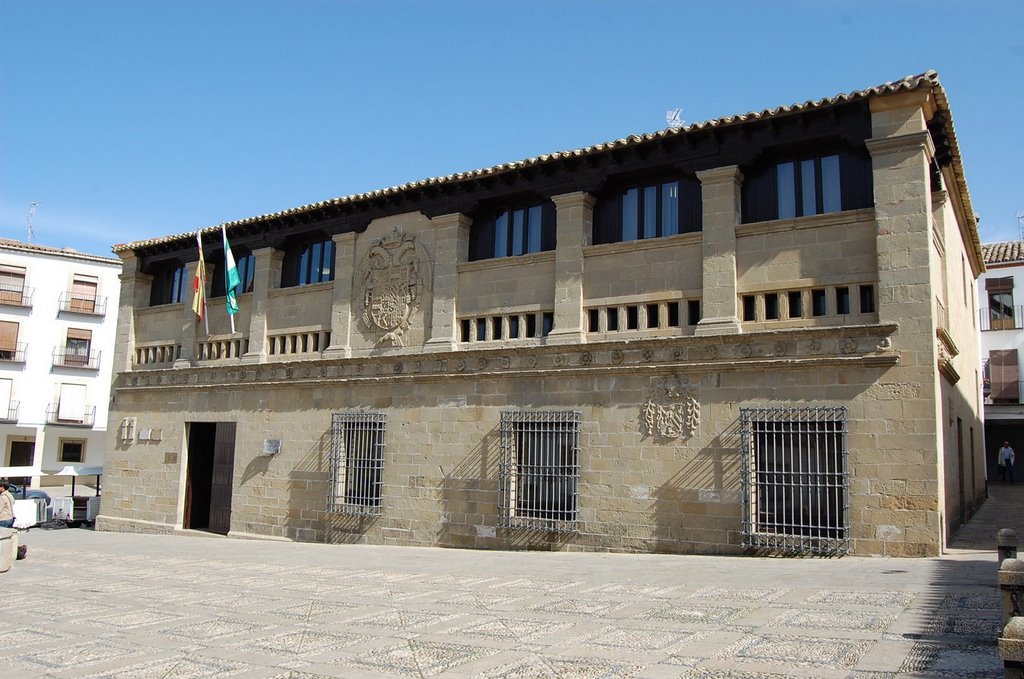
This stately building was also moved here stone by stone
– but not from Cástulo. It was the old
butchers shop (Antigua Carniceria) which stood about 100
yards from this site. What does it say about a society
when the slaughterhouse looks this good? Today this 16th
century Renaissance jewel has a more dignified role as
the judicial center. (Do those barred windows keep people
out or in?)
At center of the upper floor we see...
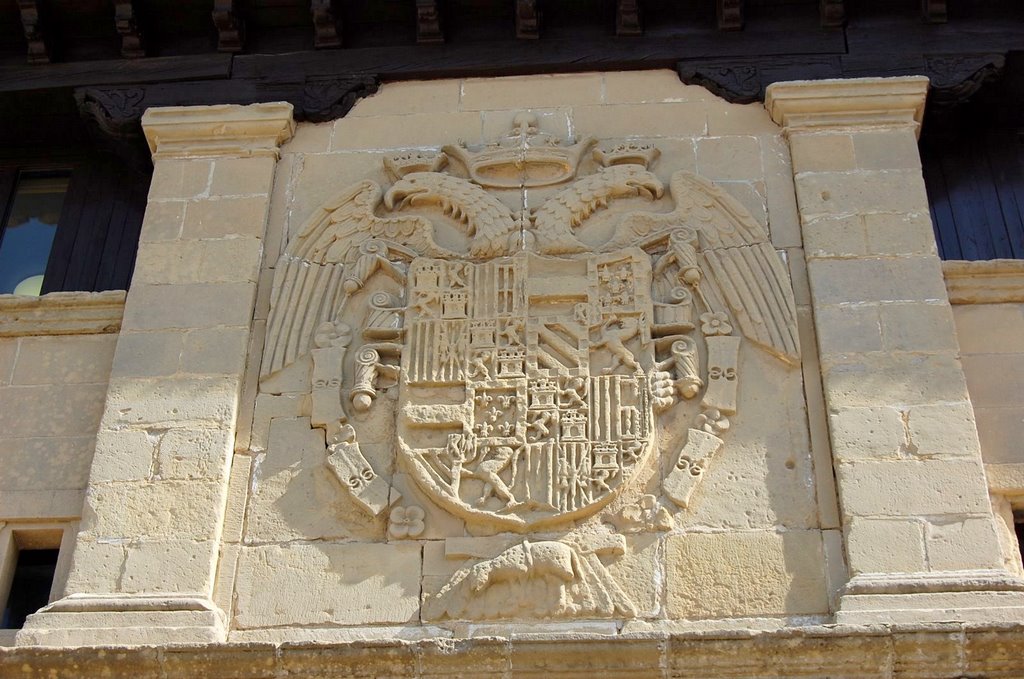
...the Emperor's coat-of-arms. The double eagle is that
of the Holy Roman Emperor who borrowed the image from the
Byzantine Empire which kept Rome alive (more or less) in
the East until the 15th century. This shield is of
Charles V. His ancestors participated in enough
sanctioned incest so that he inherited through 4
different royal lines -- giving his crest four inner
shields representing each of the lines of descent.
Charles became a biological European Union. Since his
family tree didn’t branch, he suffered from the
Hapsburg jaw – so misaligned that he could barely
chew (and digest his food). Epilepsy and gout also
plagued him. Today the shield of the man who
couldn’t masticate emblazons an ancient butcher
shop. Go chew on that!
Casa del Pópulo
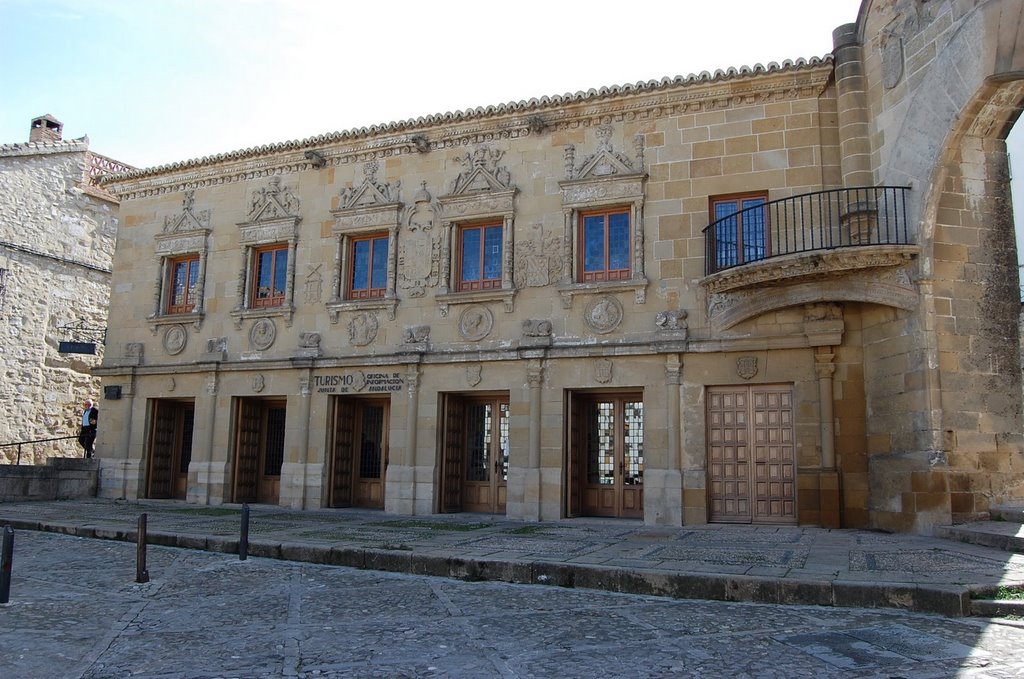
The Casa del Pópulo is now the tourist office. It
was called the Audiencia Civil y Escribanías
Públicas since townsfolks in those pre-twitter
days would come here to get documents written and read,
entering different clerks’ offices through the six
doors seen here. Its beautiful Renaissance façade
seems to have its symmetry broken by the quarter-circle
balcony which was incorporated into the old arch of a
city gate.
Medallions emblazon this Plateresque façade. At
the bottom of the picture below left is the
dilapidated seal of Baeza.
If you're into the details, click
on the picture to enlarge it to see the keys between
the arch of the castle (or click here to see a
graphic.)
The balcony on the Casa del Pópulo (pictured above
right) is quite elaborate even if a bit incongruous. In
the picture below it connects with t\one of the few
remaining city gates, the Puerta de Jaen.
Its arch bears another of Charles
V’s coat-of-arms and faces the old butcher shop
across this small square.
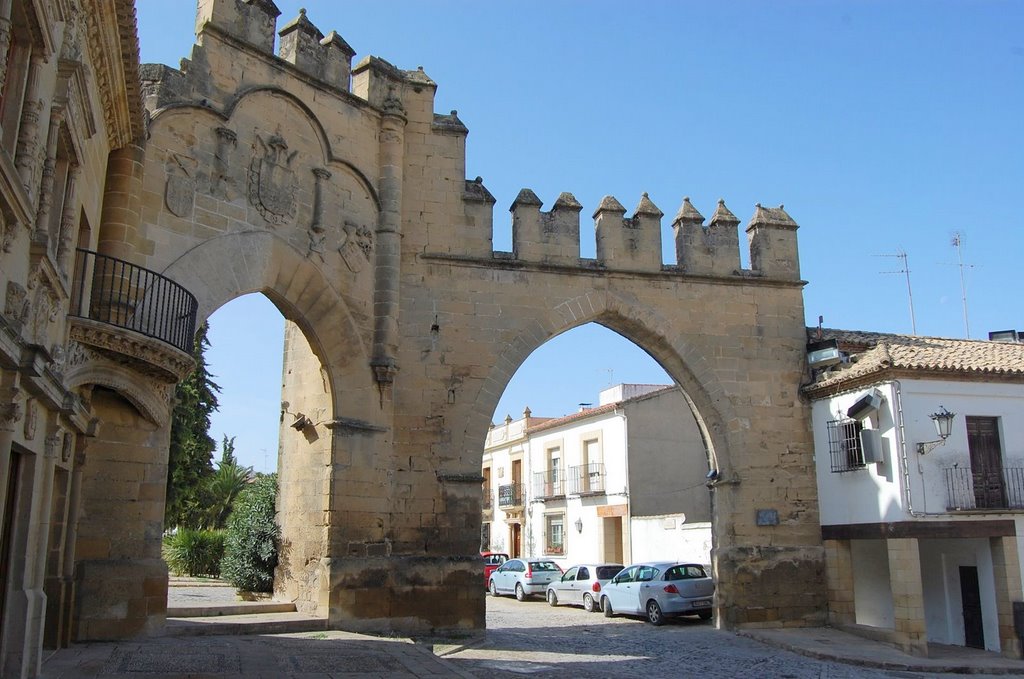
We look here past the balcony of the Casa del
Pópulo through the Puerta de Jaen (left) and a
memorial arch commemorating the April 1521 victory of
Charles V over those pesky Castilians who rebelled
against his increased taxation. This started as Charles
was tied up suppressing Luther at the other end of his
European kingdom. Luther ended his defense at the Diet of
Worms three days before his victory at the battle at
Villalar honored in stone here at right. Things would get
worse as Charles tried to preserve the Catholic Church. A
few short years later, England’s Henry VIII would
try to annul his 24-year marriage to Charles’ Aunt
Catherine. Henry appealed to the Pope who was to Henry's
chagrin then a prisoner of Charles V! (Charles's mutinous
troops would later sack Rome when he ran out of money to
pay them. Just who was defending whom?)
But not all was problematic for Charles in 1521: His
realm stretched westward to the New World and Magellan
had just sailed into what would be called the Philippines
when it was named for Charles' son and successor Philip.
But eventually it all became too much and Charles
resigned his emperorship in 1556.
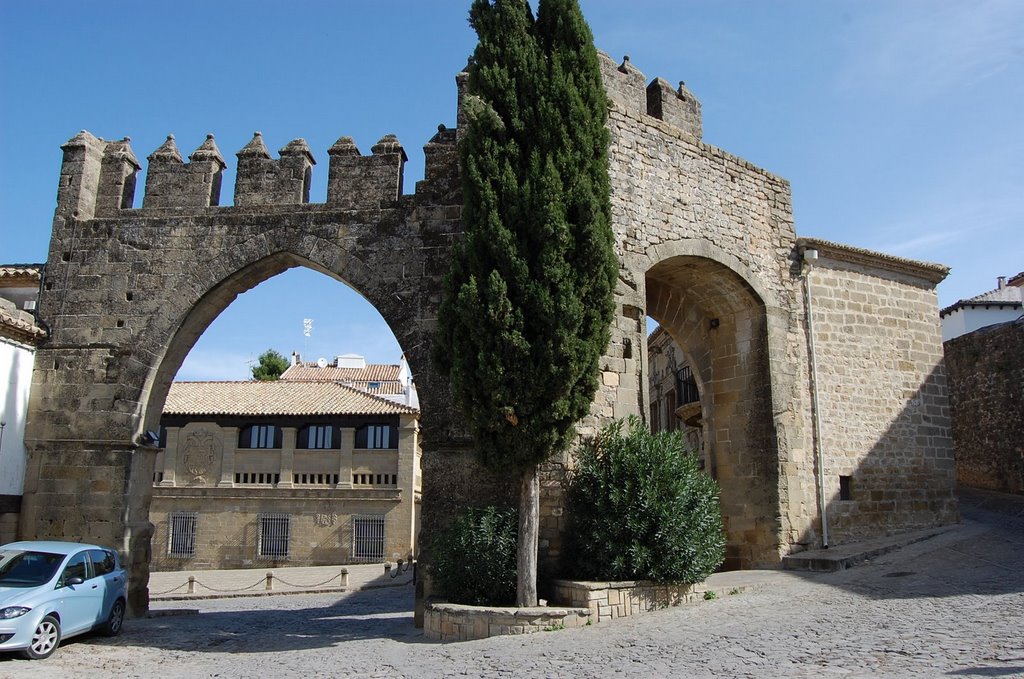
But Charles V's visit to Baeza came at a happier time
when he stopped here in 1526 on his way to marry Isabel
of Portugal (his cousin, of course. In those days
European royalty were redefining the concept of kissing
cousins.)
Only a few remnants of the old fort (Alcazar) and the
towns defensive towers, walls, and gates still stand
after 1476 when Queen Isabel ordered them destroyed,
hoping to end the nearly constant civil war between the
town’s two most powerful families. In many
Andalusian towns, one family would capture the old
fortifications and use it as a base to attack their
rivals. After Ferdinand and Isabel complete the
Reconquista, they removed much of these fortifications
since they no longer needed them to defend against the
Moors. In Andalusia, the enemies now were to come from
within (until Napoleon arrived three centuries
later.)
Note how much thicker the walls were of the defensive
gate (Puerta de Jaen) at right in the above picture vs.
the commemorative arch (Arco de Villalar) at left.
Please join us now for our last stop at an
ingenously "restored" Vandelvira building
by clicking here.
Please join us in the following slide show to
give Baeza the viewing it deserves by clicking here.
|
|
|
|
Geek and Legal Stuff
Please allow JavaScript to enable word
definitions.
This page has been tested in Internet
Explorer 7.0 and Firefox 3.0.
Created on 15 March 2009
|
 |
TIP:
DoubleClick on any word to see its definition.
Warning: you may need to enable javascript or allow
blocked content (for this page only).
TIP:
Click on any picture to see it full size. PC
users, push F11 to see it even larger.
